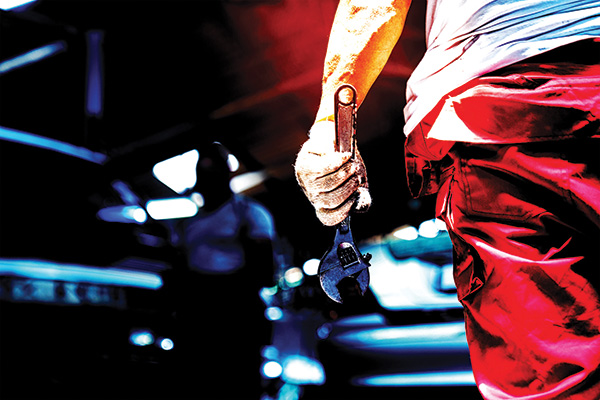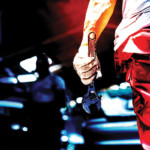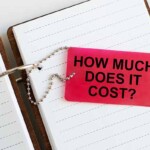
A Risky Business: Understanding Shop Liability
Published in Hammer & Dolly – Thomas Greco Publishing
“Without risk, there is no reward” – perhaps this well-known and often-repeated saying helped you find the courage to pursue your dreams of a career in the collision repair industry or even open your own shop. But while some risks are worth taking, others simply expose your business to liability and endanger your livelihood.
 Between technological advancements in today’s constantly changing vehicles, environmental requirements and workplace safety concerns, it’s necessary to recognize the various accountabilities that fall on shops and identify methods to circumvent those potential liabilities to protect the business.
Between technological advancements in today’s constantly changing vehicles, environmental requirements and workplace safety concerns, it’s necessary to recognize the various accountabilities that fall on shops and identify methods to circumvent those potential liabilities to protect the business.
As Warren Buffett said, “Risk comes from not knowing what you’re doing,” so it’s vital for shops to understand all the areas in which they have certain responsibilities. That begins with safe and proper repairs – poor workmanship can open shops up to liability concerns with consumers, insurers and OEMs.
“Today’s repairs, in nearly all situations, affect the performance and possibly the safety of the vehicle,” notes Michael Giarrizzo (DCR Systems). “Our responsibility, as repairers, is a safe and proper repair guided by manufacturer work instructions. Strict adherence to those work instructions with extensive documentation of what is needed to be done as well as validation that the repairs were actually performed in that way. Complete transparency is imperative!”
“It’s a matter of process and procedure, starting at the repair planning stage with pulling OE repair procedures, having the right equipment and implementing quality control checkpoints throughout the repair process,” offers Ron Reichen (Precision Body and Paint). He elaborates, “The person performing the quality control and approving the repair should not be the same person who did the work; it needs to be a different set of eyes, someone who is responsible for reviewing the work and determining whether it’s acceptable or not acceptable.”
“Quality verification throughout the repair process is critical,” agrees Cheryl Boswell (DCR Systems).
As post-repair inspections become more common, poor workmanship opens shops up to culpability. “We all remember the Seebachan case that finally broke that glass ceiling,” recalls Mark Allen (Audi of America). “Those poor people are in so much pain every minute of every day, and the money is not worth the pain. Could you live with your conscience knowing something like that happened? It’s a morality thing. The fact of the matter is, we’re charged with keeping those people safe, all of us – from the manufacturers to the insurers, right down to the technician.”
Shops can protect themselves by investing in the proper training, tools and equipment to perform repairs, but they also need to document every step of the repair process to prove they’ve done things the right way. “Document everything you do with images and photographs to support it,” Reichen recommends. “Full transparency helps shops avoid legal action. If our repair plan says we’re going to do A, B and C, we want photos to support each step as well as the end product. We should be able to produce invoices that demonstrate the parts were purchased as well as photos showing that the part was installed on the vehicle.”
“With today”s complex safety and driving assist systems, we must adopt complete transparency and accountability through extensive and detailed documentation,” Giarrizzo concurs, adding, “Improper repairs affect the safety and performance of these complex vehicle systems. The history of repairs will start to come into play in a subsequent accident. OE guidelines and work instructions are engineered so that the vehicle responds the way it was intended to in another accident, [and if it fails], the liability falls on the shop that did the repairs.”
“It not only impacts the vehicle value, but can lead to serious injuries to consumers if their vehicles are not repaired correctly,” Boswell contributes.
Reichen offers a few examples of ways that improper repairs can impact consumers and create liability issues for shops. “If a door latch fails and the door opens, somebody could fall out of the car. Safety checks on seatbelts often get neglected. Headlight alignment is important to ensure consumers can see the road properly. If you take on calibrations in-house, there’s a huge liability if the camera isn’t aimed properly and that car backs over a kid on a tricycle. We need to research the requirements, add them to the repair plan and then actually do them.”
Obviously, the customer’s safety should be the primary concern during every single repair, but as businesses, shops are also responsible for the customer service aspect of the equation. When a customer has a negative experience during the repair process, they typically blame all related parties – the shop, manufacturer and insurance carrier – regardless of who was actually at fault in their unique situation, so a shop’s failure to meet a customer’s expectations (especially related to safety) can create rifts in the facility’s relationships with insurers and manufacturers as well.
“Confidence, trust and risk exposure hits everyone,” Giarrizzo insists. “Brand protection can be compromised by certain behaviors, plus repairer/insurer relations become strained.”
“For OEs, the brand impact [of an improper repair] can be immense,” Allen points out. “We’re partners, whether we want to admit it or not. Either manufacturers, insurers and shops pull together to create the perfect team, or the process devolves into a huge mess. When we work together, we can reduce liabilities for all of us. If we all come together to provide a positive experience for the customer, nobody needs to blame anybody else. And we all profit because we’re in business to make money.
“As manufacturers, we build a car that meets federal standards and performs as it was designed, and then we make the repair procedures available through OEM1stop.com,” he continues. “Shops need to access those procedures to perform a safe and proper repair and then reach out to the insurance carrier to explain what processes are required and how it’s done using the correct tools and equipment. Once the repair is done, our mutual customer is taken care of – they are restored financially so the only impact is their deductible, and their vehicle is returned with the repairs completed in a manner that ensures it will perform the same if a subsequent accident occurs.”
For certified shops, adhering to the OEMs’ requirements isn’t optional. “If you don’t follow your OE certification, you’re subject to be removed from that program,” Reichen acknowledges. “Follow the OE’s procedures, document it with images and make sure you’re doing it. Some insurers may try to dictate what they’re going to pay you, but you have all the liability, so it’s up to you to insist on performing the repair properly.”
“The lack of knowing or understanding regulations or statutes increases your risk of being held liable. The duty of care owed plays into it as well,” adds David Willett (SPARK Underwriters), taking it a step further to emphasize that, while training is vital, it’s even more important to implement that knowledge. “Your risk can actually increase because you do know, understand, have been certified or obtained knowledge.”
In addition to liability concerns related to workmanship that affects consumers and other facets of the industry, collision repair shops have a ton of internal responsibilities that can open them up to legal actions if not handled properly.
One area that shops often neglect to consider relates to employment law, and Willett offers advice on a fact that all shops should be aware of. “If someone inquires to apply for a job with your business, they fall under employment law. One way that has been recommended to lower the risk is to provide everyone with an application.”
Workplace safety should be a top priority in every type of business, but in shops where there are so many hazards, employers need to take special care to stay abreast of possible issues and circumvent them.
“Shops need to review safety policies and procedures regularly and update as appropriate. They need to self-audit as well as bring in an independent source to validate,” Giarrizzo insists.
“Housekeeping is critical,” Reichen says. “Are all your electrical cords in good working orders with ground plugs in place? Are any of your airlines leaking which could cause them to blow out, whip around and hit someone or create damage? Make sure your fire extinguishers are checked on a regular basis, and if you’re repairing EVs, you need a specific extinguisher for electrical fires. You also need to follow EV safety requirements, like investing in the gaff hook, high-voltage gloves and non-conductive shoes, plus ensuring that eye protection is worn and no one working on an EV wears any conductive jewelry.
“Anyone driving a forklift should have the proper training and certification,” he continues. “Implement frame rack safety protocols, using a spotter so no one drives a vehicle off the rack. Seal flammables in metal-sealed containers to prevent exposure to sparks, and invest in high-quality welding blankets made from non-flammable materials. Know how to deal with hazardous waste spills and address leaks right away so it doesn’t cause someone to slip and the fluids don’t seep into the storm sewer in the parking lots. Essentially, shops need to make sure they’re aware of all the possible situations that can occur and ensure they have the proper training and equipment to handle it and that everyone on the team is conscientious of those hazards and understands how to address them if they occur.”
“Shops need to make sure their teams are using all of the proper safety equipment, such as protective eye wear, shoes, respirators, etc,” Boswell adds, listing additional items that shops should keep in mind: “There are safety issues such as fires. EV batteries introduce new risks as well. And then there are safety hazards that are also related to environmental requirements, such as the need for shops to use outside parties to remove waste.”
Failure to adhere to environmental regulations can also open shops up to liability risks. Giarrizzo recommends that shops perform “consistent reviews of environmental regulations and validate that they are being addressed appropriately. Outside independent self-initiated audits can help mitigate risks as well.”
“Know what needs to be disposed of separately,” Reichen offers. “Properly contain and evacuate your freon materials and other discharged fluids, such as coolant. Change paint booth filters according to the manufacturer’s schedule and dispose of them in a standardized manner. A lot of the stuff we deal with in the shop can’t just be thrown in the dumpster with cardboard and other garbage, and if an OSHA inspection finds that you’re not disposing of these materials properly, the fines are significant; you can even end up in a position where they shut your shop down!”
Each state’s environmental laws vary, so it’s imperative to be aware of your jurisdiction’s requirements.
“All businesses are subject to environmental regulations, but the automotive industry has specific details that can vary by state and locality,” Willett explains, recommending shops familiarize themselves with their obligations by actively participating in collision industry associations, 20 groups and local business groups as well as by seeking advice from knowledgeable professionals, such as lawyers, IT providers and their insurance carriers.
Carrying the right business insurance is a vital component for shops seeking to protect themselves from all sorts of liability. But “the appropriate coverage needs to be in your body shop business insurance policy prior to the accident, fire, crime or faulty repair,” Willett advises.
He recommends making sure shops’ policies include coverage for the exposure to loss in several categories, including specialty liability – “employment practices liability including discrimination and sexual harassment, cyber risk and employment benefits liability. These are usually written on a claims made basis to avoid long tail exposure. Make sure your retroactive date is set to keep from having a gap which leads to you self-insuring.”
Property coverage should encompass “buildings, including everything permanently attached, such as paint booths and inground lifts; business personal property owned by the insured – everything that falls out if you take the building upside down and shake it – materials, equipment, paint, computers, furniture and parts,” according to Willett. “Also, be sure this encompasses coverage for business income and extra expense to survive and recover after a covered peril loss and employee tools which can be marketed to your team as an additional employee benefit because, last time I checked, it is eight to 10 times more expensive for your employees to insure their tools on their own personal insurance policy. Be aware of the limits within those policies as well; many times there is a per tool or per employee limit of $1,000s or a low total limit which is less than the cost to replace one tool box.”
When it comes to making sure a shop’s policy offers adequate limits, Willett suggests calculating completed operations limits with an “underlying policy of $1 million with an aggregate of one to two times and then an umbrella limit on top. Your property limits should include the cost to replace a building with like kind and quality of construction materials is analogous to repairing a vehicle after an accident. It usually costs much more to repair a vehicle than to build one from scratch. The same is true for a building after a loss. The market value of the building does not include the increased costs of building materials, labor rates and new building codes. Also, pay attention if the foundation is included in the definition of the building. Several sources have estimated the cost of parts and materials has increased 10 percent year over year, so your business personal property limits most likely need to increase to prevent you from self-insuring.”
Although mitigating some of these risks may seem costly in terms of both time and money, experts agree that it’s worth the investment. According to well-known businessman and economist Gary Cohn, “If you don’t invest in risk management, it doesn’t matter what business you’re in – it’s a risky business.”
Allen agrees. “Risk management puts you in a defensible position, and without it, you have no defense. It may be painful at times when it affects your overhead, but at the end of the day, it’s the right thing to do.”




